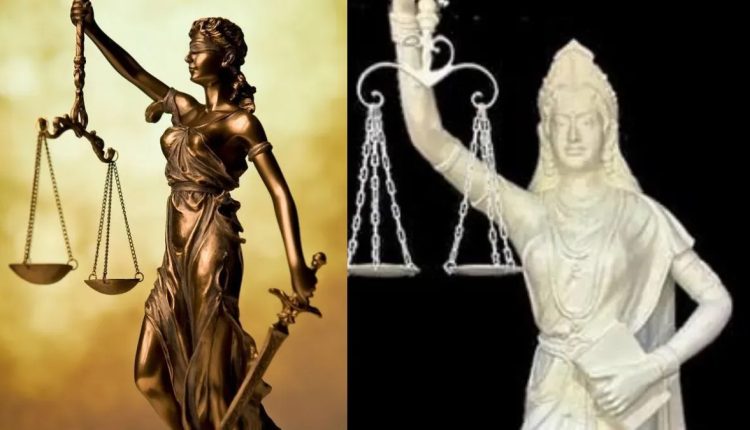Bibhuti Pati
The statue of ‘Lady Justice’ was recently unveiled by Chief Justice of India DY Chandrachud in the judges’ library of the Supreme Court, although media attention on the matter has only emerged now. It is thought that a mural located in the Judges Gallery inspired the Chief Justice to Indianize the statue, reflecting the evolving character of the Indian justice system. This mural portrays Lady Justice as an Indian goddess, with her eyes open and without a blindfold; she holds a book, presumably the Constitution of India, in place of the traditional sword, indicating that justice in this nation is not blind and does not solely represent punishment in contemporary India.
The alteration in the statue’s design, which has long been associated with judicial and legal institutions, is being characterized by some legal experts and media sources as an effort to move away from colonial influences and traditional representations, although this interpretation may not be entirely accurate. The Supreme Court has introduced a new interpretation of “Lady Justice,” diverging from the conventional image of a blindfolded woman wielding scales in one hand and a sword in the other, which is widely recognized in legal contexts globally. The newly unveiled six-foot-tall statue in the judges’ library features a saree-clad woman without a blindfold, holding scales and a copy of the Constitution of India instead of a sword.
The traditional depiction of the blindfold has commonly been interpreted as a symbol of justice’s impartiality. In contrast, the newly unveiled statue, which features unimpeded vision, conveys the message that “Law is not blind; it sees everyone equally,” as articulated by Chief Justice of India D Y Chandrachud, who commissioned the work. This modern interpretation, crafted by Vinod Goswami, a muralist and educator at the College of Art in Delhi, emerges in the context of recent legal reforms, including new criminal codes, and reflects the objective of “decolonising” India’s legal framework.
From Greek
The representation of Lady Justice has its origins in Greek and Roman mythology. Themis, one of the twelve Titans born to Gaea and Uranus, is recognized as the goddess of justice, wisdom, and good counsel, as described by the Greek poet Hesiod around 700 BCE. She is typically portrayed as a woman holding scales in one hand and a sword in the other. The first Roman emperor, Augustus (27 BCE-14 CE), initiated the veneration of Justice in the form of a goddess named Justitia (or Iustitia). Similar to Themis, Justitia was not depicted with a blindfold.
In a 2020 paper, legal scholar Desmond Manderson from the College of Law at the Australian National University noted that the earliest known depiction of a blindfolded figure of justice originates from a woodcut featured in “Ship of Fools,” a collection of satirical poems by the 15th-century lawyer Sebastian Brant. Manderson emphasized that this 1494 image is not intended as a tribute to blind justice but rather as a critique.
The woodcut, often credited to the German Renaissance artist Albrecht Dürer, is titled “The Fool Blindfolding Justice” and illustrates a fool placing a blindfold on a woman resembling Lady Justice, who holds a sword in one hand and scales in the other. However, by the early 17th century, Manderson observed that the image had shed its satirical implications and had become synonymous with the concept of justice itself.
Lady Justice in India
The common law legal system, which underpins the functioning of India’s judiciary, was established during the British Raj, which also introduced the symbol of Lady Justice. This representation continues to be present in courthouses throughout the nation. At the Calcutta High Court, originally built in 1872, carvings of Lady Justice adorn the pillars that support the structure. These representations vary, with some depicting her blindfolded and others showing her with her eyes open. Similarly, the Bombay High Court features a statue of Lady Justice atop one of its buildings, notably without a blindfold. A newly installed statue at the Supreme Court closely resembles another artwork located on the premises. A mural near the judges’ entrance illustrates Mahatma Gandhi alongside Lady Justice, who is depicted wearing a saree and holding scales and a book, rather than a sword, positioned on either side of a chakra.
Protests in Bangladesh
In December 2016, a significant statue of the goddess Themis was installed in the main plaza of the Supreme Court of Bangladesh. Adorned in a sari and blindfolded, the statue held a set of scales and a sword. This installation sparked protests from the Muslim orthodoxy, who raised objections on the grounds of idol worship. By May 2017, the statue was relocated to a less visible area within the Supreme Court premises. Following the collapse of the Sheikh Hasina government in August 2024, the statue was ultimately destroyed.
From the perspective of the critics
Critics argue that substituting the sword with the Constitution in the hands of Lady Justice is an inappropriate decision. In Indian mythology, deities are often depicted wielding weapons to vanquish malevolent forces. The essence of justice is contingent upon the existence of a robust mechanism to enforce court rulings through coercive means. The Supreme Court Bar Association (SCBA) has adopted a resolution opposing the modifications made to the emblem of the Supreme Court and the statue of Lady Justice, citing a lack of consultation with its members.
It is essential to distinguish between law and justice. The book held by the statue represents the significance of law, while the sword embodies the necessity of delivering justice to victims at the grassroots level. Justice Krishna Iyer, in the All-India Judges case (1992), noted that law serves as a means to achieve the ultimate goal of justice. Consequently, the new statue is deemed incomplete without a representation of coercive power to ensure the enforcement of court orders. Absent such power, the concept of justice remains fundamentally flawed.
The Executive Committee of the Supreme Court Bar Association has remarked that recent unilateral changes made by the Supreme Court, including alterations to its emblem and the statue of Lady Justice, were executed without prior consultation with the Bar. The resolution states, “We are equal stakeholders in the administration of justice, yet these changes were never communicated to us. We are entirely unaware of the reasoning behind these modifications.”
In conclusion
In the case of Zahira Sheikh v. State of Gujarat (2004), the Supreme Court had the opportunity to revisit the notion of the blindfold. Zahira Sheikh, a victim of the Godhra riots, retracted her statements before the court on three separate occasions. The Supreme Court indicated that the blindfold should merely serve as a veil that can be lifted by the court when necessary, allowing it to discern the identities of the parties involved to avert any miscarriage of justice.
At a metaphysical level, scholars contend that simply unveiling the eyes of the statue and substituting the sword with a replica of the Constitution does not constitute the Indianisation of the concept of justice, as is often exaggerated. They assert that in Indian mythology, both deities associated with justice are male—Shani Dev, who administers justice during a person’s life, and Yamaraja, who dispenses justice posthumously. Ideally, to truly Indianise the concept of justice, the statue of Lady Justice should be replaced with an Indian deity representing justice.

